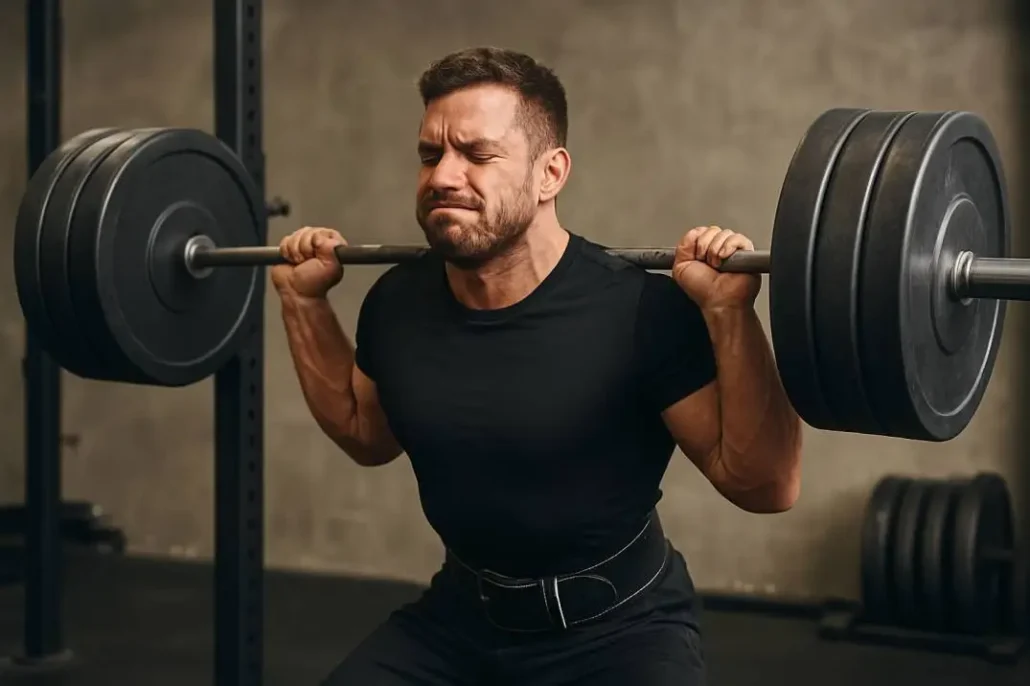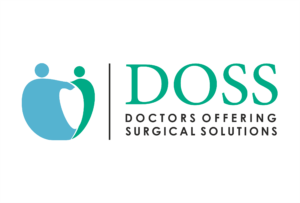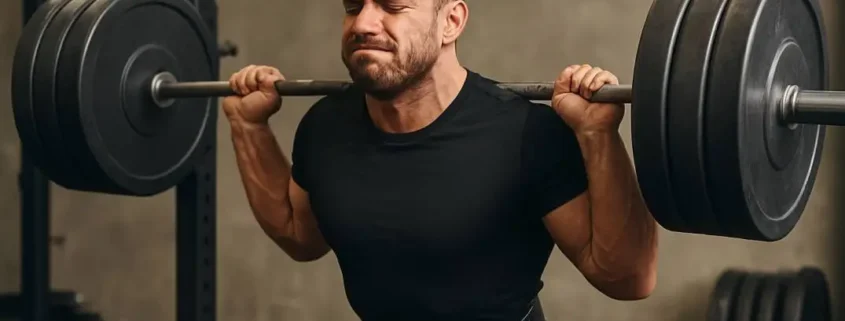Lifting Heavy, Staying Safe: A Pro’s Guide to Hernia Risks
BlogFor professional weightlifters, pushing the body to its absolute limit is part of the job. Every training session is a calculated effort to build strength, power, and muscle.
But with great force comes great risk, and one of the most common concerns for any serious lifter is the potential for a hernia. That sudden twinge or persistent bulge can be more than just a setback; it can be a career-threatening injury.
Understanding this risk is the first step towards preventing it. The immense intra-abdominal pressure generated during heavy lifts like squats and deadlifts puts significant strain on the abdominal wall.
While this pressure is necessary for stabilising the spine, it can also force tissue through a weak spot, leading to a hernia.
This guide will provide a comprehensive overview of hernia risks for professional weightlifters.
We will explore what causes them, the specific types lifters are prone to, crucial prevention strategies, and what to do if you suspect you have one.
Our goal is to equip you with the knowledge to train smarter, lift heavier, and protect your body for the long haul.

What is a Hernia and Why Are Weightlifters at High Risk?
A hernia occurs when an internal organ or fatty tissue pushes through a weak spot in the surrounding muscle or connective tissue, called fascia.
For weightlifters, this risk is significantly elevated due to the nature of their sport. The core of the issue is intra-abdominal pressure (IAP).
When you perform a heavy lift, you instinctively perform the Valsalva manoeuvre—bracing your core and holding your breath to create a rigid torso.
This action dramatically increases IAP, which helps protect your spine but also exerts immense force on your abdominal wall, particularly in the groin and navel areas. If there is a pre-existing weakness, this pressure can be the final push that causes a hernia.
What are the main types of hernias that affect weightlifters?
While several types of hernias exist, weightlifters are most susceptible to specific kinds due to the mechanics of lifting.
- Inguinal Hernias: These are the most common type, especially in men. They occur when part of the intestine or abdominal fat protrudes through the inguinal canal in the groin. The constant, high-pressure strain from lifting makes this a particularly vulnerable area.
- Umbilical Hernias: An umbilical hernia happens when tissue bulges through the abdominal wall near the navel (belly button). This area can be a natural weak point from birth, and the intense pressure from lifting can cause it to tear or stretch, leading to a hernia.
- Incisional Hernias: If you have had previous abdominal surgery, you are at risk for an incisional hernia. The surgical scar tissue is never as strong as the original muscle wall, and the strain of lifting can cause it to give way.
- Sports Hernias (Athletic Pubalgia): A sports hernia is not a true hernia but a strain or tear of any soft tissue (muscle, tendon, or ligament) in the lower abdomen or groin area. It causes chronic pain and is often the result of repetitive, forceful twisting or turning motions, which can be part of a dynamic lifting regimen.
Dig deep:Types of Hernia
How to Identify the Symptoms of a Hernia?
Recognising the early signs of a hernia is critical for preventing further damage. Ignoring these symptoms can lead to more severe complications, such as strangulation, where the blood supply to the herniated tissue is cut off. This is a medical emergency.
Common Signs and Symptoms
- A Noticeable Lump or Bulge: This is the most classic sign. You might feel or see a bulge in your groin or abdomen, which may become more prominent when you are standing, coughing, or straining. It might disappear when you lie down.
- Pain or Discomfort: You may experience pain or a dull ache in the affected area, especially when lifting, bending over, or coughing. The pain can range from mild to severe.
- A Feeling of Fullness or Pressure: Many athletes report a feeling of heaviness, weakness, or pressure in their groin or abdomen.
- Pain Radiating to Other Areas: For inguinal hernias, pain can sometimes radiate into the testicles or inner thigh.
If you notice a bulge accompanied by sudden, severe pain, nausea, or vomiting, you must seek immediate medical attention as it could be a sign of a strangulated hernia.
Dig Deep: How to Identify Hernia at Home?
Can Proper Lifting Technique Prevent a Hernia?
Yes, proper lifting technique is your single most important defence against hernias. While some individuals may have a genetic predisposition to weaker connective tissue, poor form significantly multiplies the risk. It places uneven and excessive stress on the abdominal wall.
Key Technical Elements for Hernia Prevention:
1.Master Core Bracing: Learn to brace your core effectively without creating excessive, uncontrolled pressure. This involves contracting your entire abdominal wall, obliques, and lower back to create a “natural weightlifting belt.” The goal is stability, not just sucking in your stomach.
2.Control Your Breathing: Avoid holding your breath for too long or with excessive force (an extreme Valsalva manoeuvre). A controlled exhale during the most strenuous part of the lift can help manage intra-abdominal pressure. Work with a coach to perfect the timing of your breath with each specific lift.
3.Ensure Neutral Spine Alignment: Maintain a neutral spine throughout the entire range of motion. Allowing your lower back to round during a deadlift or squat shifts the load and can create dangerous pressure spikes in the lower abdomen.
4.Avoid Ego Lifting: Progress gradually. Lifting weight that is too heavy for you forces a breakdown in form, which is a direct path to injury. Listen to your body and prioritise perfect execution over the number on the bar.
Read: Can Heavy Lifting Cause Hernia ?
Do Weightlifting Belts Cause or Prevent Hernias?
This is a common and controversial question. A weightlifting belt does not directly prevent a hernia, but when used correctly, it can help reduce the risk.
A belt works by providing external pressure against your abdomen. This gives your core muscles a surface to push against, helping you increase intra-abdominal pressure more effectively and safely.
This enhanced stability can lead to better form and a more protected spine.
However, improper use can be detrimental. Relying on a belt too much can prevent your core muscles from developing their own strength.
Furthermore, wearing a belt excessively tight can create extreme pressure, potentially increasing the risk of a hernia if your bracing technique is poor.
Belt Usage | Potential Outcome |
Correct Use | Used on maximal or near-maximal lifts; encourages proper bracing, helps maintain neutral spine, reduces injury risk. |
Incorrect Use | Worn too tight, used for all lifts, relied upon as a crutch; can lead to a weak core and potentially increase hernia risk. |
The takeaway is that a belt is a tool, not a solution. It should supplement strong technique, not replace it.
Returning to Lifting After Hernia Surgery
A hernia diagnosis doesn’t have to be the end of your lifting career. With proper surgical repair and a carefully managed recovery, many athletes return to their previous strength levels.
Recovery is a gradual process that must not be rushed.
- Immediate Post-Op (Weeks 1-2): Focus on rest. The only activity should be light walking to promote blood flow. Avoid any lifting, straining, or core engagement.
- Early Recovery (Weeks 3-6): Your surgeon will guide you on when to begin. Typically, you can introduce light bodyweight exercises and focus on re-engaging your deep core muscles. No lifting or straining is permitted.
- Progressive Loading (Weeks 6-12+): This is the crucial phase. Under medical guidance, you can begin slowly reintroducing light weights. The focus must be on flawless form and listening to your body. Start with machines before moving to free weights, and begin with weights that are 50% or less of your pre-injury lifts.
- Full Return: A full return to professional-level lifting can take anywhere from 3 to 6 months, and sometimes longer. It is vital to remain patient and prioritise long-term health over short-term gains.
Key Takeaways
- Weightlifters are at high risk for inguinal and umbilical hernias due to the high intra-abdominal pressure created during heavy lifts.
- Symptoms include a visible bulge, pain or aching in the groin or abdomen, and a feeling of pressure, especially when straining.
- Proper lifting technique, including core bracing, controlled breathing, and neutral spine alignment, is the most effective prevention strategy.
- A weightlifting belt can be a helpful tool for managing pressure on heavy lifts but does not replace the need for a strong core and good form.
- Recovery from hernia surgery requires patience. A gradual, medically supervised return to lifting over 3-6 months is essential for a safe and successful outcome.
Frequently Asked Questions (FAQ)
Q: Can you feel a hernia developing?
A: Sometimes. You might feel a dull ache, a sense of pressure, or a slight twinge in your abdomen or groin before a noticeable bulge appears. Any new or persistent pain in these areas during or after lifting should be monitored closely.
Q: Will a hernia go away on its own?
A: No, a true hernia will not heal on its own. While symptoms may come and go, the underlying weakness in the muscle wall remains. Surgical repair is typically required to fix a hernia permanently.
Q: Can I continue to lift weights if I have a small hernia?
A: This is strongly discouraged. Lifting with an existing hernia can cause it to enlarge and significantly increases the risk of a dangerous complication like strangulation, where blood flow to the trapped tissue is cut off. You should always consult a doctor for diagnosis and guidance.
Q: Are some exercises more likely to cause a hernia than others?
A: Yes, exercises that generate maximum intra-abdominal pressure, such as heavy squats, deadlifts, and overhead presses, carry the highest risk. However, any lift performed with poor form or excessive weight can contribute to a hernia.


 +919011100010
+919011100010 


